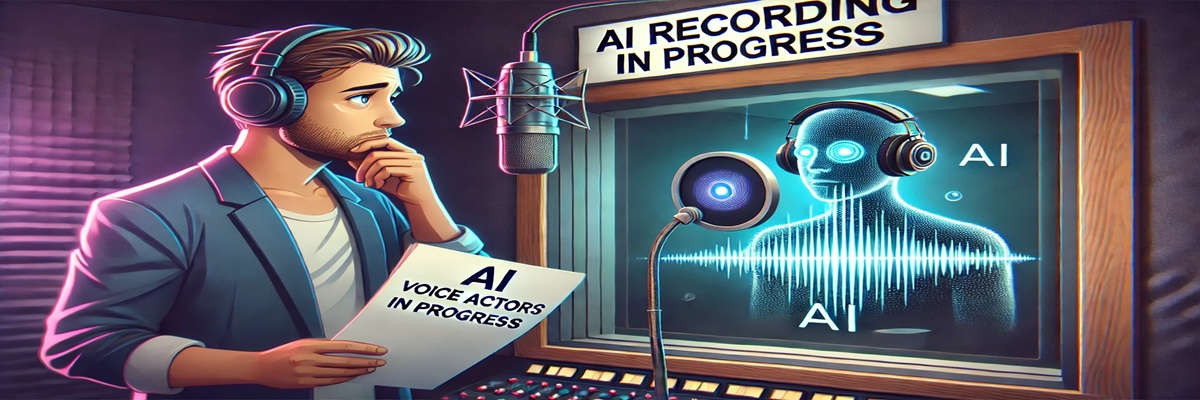The rapid advancements of artificial intelligence have touched nearly every corner of the entertainment world, and the voiceover sector is no exception. As studios and game developers experiment with AI-generated dialogue and synthetic voices, voice actors find themselves at a crossroads. Some see AI as a tool that might streamline tedious tasks, while others worry that it could displace their craft altogether. This article explores how AI is affecting the voiceover industry, why voice actors are feeling uncertain or uneasy, and what steps can be taken to protect authenticity and creative dignity.
Understanding the Rise of AI in Voice Acting
Voice actors have historically relied on auditions, in-studio direction, and personal relationships with sound engineers to breathe life into characters. Today, advanced neural network models can capture the essence of an actor’s vocal qualities by analyzing hours of recorded material. Then, with relative ease, these programs can generate new lines in the actor’s style—without the actor ever stepping into a recording booth again.
For game and animation studios under constant pressure to update content, this technology offers tempting perks. AI could quickly provide background chatter, fix script revisions, or produce additional lines for expansions. In that sense, it appears to lighten the workload for producers and may reduce costs tied to scheduling additional sessions with an actor. Yet, for the performers who spent years refining their craft, the thought of a computer replicating their emotional inflections can spark alarm. The fear is that an intangible creative spark—a synergy that emerges during live interaction—could be lost in AI-generated performances.
The Emotional Core: “I Can’t Be Friends With the Machine”
In a revealing perspective shared by audio professionals, one voice actor admitted, “I can’t be friends with the machine,” summing up the uneasy sentiment many feel toward AI. When providing lines for a game or cartoon, performers typically interact with directors, co-actors, or even animators to shape comedic timing or dramatic tension. That bond underlies an essential aspect of voice acting: the interplay of creativity between people.
But if AI steps into that collaborative space, delivering lines or adjusting emotional cues automatically, voice actors worry that their personal relationships with directors and sound teams might degrade. Instead of a dynamic environment where an actor can ad-lib comedic beats or discover new emotional depths, the process risks becoming impersonal. Once recorded data is fed into a model, the performer’s presence might no longer be required for expansions or sequels. This sense of displacement isn’t just about losing a paycheck but also about losing the camaraderie, spontaneity, and respect that come with being a recognized contributor to a project’s narrative vision.
Ethical and Professional Concerns for Voice Actors
Voice actors are not merely losing out on intangible aspects of performance—they face immediate threats to their labor rights. AI technology, once armed with the “voiceprint” of an actor, can generate lines that mimic pitch, accent, and emotional tone surprisingly well. If a studio obtains these samples legally, it might craft entire sets of lines for updated content without paying the actor for additional sessions.
This scenario raises the specter of indefinite usage. Unless an actor’s contract explicitly forbids AI replication, a game developer could theoretically store the voice data and continue using it even if the actor never agrees to future roles. Such a scenario upends the concept of creative control and residual payments. Typically, voice actors receive session fees or profit shares based on the success and longevity of a project. But if AI replication becomes the norm, that entire model collapses.
Unions and advocacy groups have begun discussing how to add protective clauses to contracts that regulate AI usage. Measures may include ensuring voice actors must opt in, clarifying how many lines can be generated with AI, or establishing extra compensation if an actor’s voice is replicated. Without these safeguards, big studios might see an opening to reduce labor costs by skipping re-hiring fees or negotiation with established voice talents, effectively overshadowing the performer’s significance.
AI Tools: Potential Gains and Looming Threats
While the outlook can appear dire, some in the voiceover community note that AI might be beneficial in specific contexts. For instance, adjusting minor lines or crowd chatter can become laborious for large-scale games that need hundreds of background interactions. If AI can handle quick placeholders, possibly these tools allow the real actors to focus on crucial storylines and complex characters. That approach could streamline the production pipeline, letting the performer bring their best to the scenes that matter.
However, a large gulf separates these small tasks—like random background NPC lines—from major character arcs. If a beloved character is recognized by a voice actor’s comedic or emotional range, can a machine truly replicate that spontaneity? Many voice artists highlight that comedic timing or tear-jerking moments demand interpretive nuance that no dataset can replicate with full authenticity. The fear arises when studios, enamored by cost savings or quick turnarounds, start seeing AI as “good enough” to replace actors entirely.
Preserving Creativity in a Tech-Driven Future
The solution may lie in forging guidelines that define the boundaries of AI usage. Some voice actors champion disclaimers akin to “no generative AI was used for these lines,” similar to how certain directors disclaim minimal computer graphics usage in practical effects-based films. This honesty resonates with fans increasingly wary of synthetic illusions overshadowing genuine performances. If a project claims “AI-limited usage,” it might signal that only mundane tasks like re-recording background lines were automated, while main character arcs remain fully in the hands of human performers.
At the same time, the voiceover world recognizes that technology is unstoppable in its evolution. So, a balanced approach is key. Rather than blanket refusal, some see a chance to harness AI for tasks that do not infringe upon the emotional or artistic core of a role. For instance, if localizing small scripts in dozens of languages, AI might generate preliminary lines that real actors then refine or correct, speeding up the process but retaining a human edge.
A Roadmap for Voice Actors: Advocacy and Education
For voice actors concerned about AI’s encroachment, a multi-pronged strategy could help:
1. Contractual Clarity: Negotiating explicit terms that forbid or restrict AI-based replication of an actor’s voice. The language may stipulate that each line generated by AI requires additional payment or actor approval, ensuring ownership remains with the creator.
2. Union Support: As more union leaders realize the scale of the threat, membership can push for guidelines that apply industry-wide. Collective bargaining can protect smaller or freelance actors who might otherwise lack the leverage to refuse certain clauses in a contract.
3. Emphasizing Interpretive Value: Voice actors who cultivate strong comedic timing, emotional depth, or improvisational skill can differentiate themselves from generic AI systems. By demonstrating that no algorithm can replicate those intangible moments, actors bolster their value in the eyes of directors and fans.
4. Open Dialogue with Studios: Encouraging honest conversations about how studios intend to use AI fosters trust. Some game developers might not fully grasp how an actor’s creative input enriches the final product. If voice actors articulate their concerns and show willingness to collaborate on limited AI usage, a balanced solution may emerge.
Where the Gaming Industry Stands
Observing the bigger picture, major game studios straddle two imperatives: deliver massive content updates quickly and maintain brand authenticity. Voice lines breathe life into game universes, turning minimal story arcs into engrossing experiences. The subtle comedic banter among an RPG’s companions or the heartfelt monologue of a first-person shooter’s protagonist can define how players connect with the narrative. If AI-based lines come across as stilted or lacking spontaneity, players might detect it, weakening immersion.
Yet, the convenience of AI cannot be dismissed. Live-service games, especially those requiring frequent expansions and updates, face a near-constant demand for fresh lines across multiple languages. The difference between employing a real actor for every minor addition vs. generating lines on the fly can be massive in terms of budget and scheduling. In an industry that frequently grapples with release deadlines and the cost of AAA production, the pressure to adopt AI solutions is strong.
Ensuring the Human Touch in an AI-Driven World
Ultimately, the tension over AI’s role in voiceover will hinge on how studios, unions, and actors negotiate. The technology is evolving, offering real-time speech synthesis that approximates emotional nuance. But among professionals, the consensus remains that no machine can replicate the intangible “soul” of a live performance—especially comedic or dramatic moments that rely on synergy between cast and director. The voiceover sector stands at a pivotal moment: embrace limited AI assistance while establishing firm ethical boundaries, or risk a future where digital clones overshadow human expression.
In a world where code can mimic nearly every vocal inflection, voice actors can reaffirm their craft by showcasing interpretive flair and pushing for legal measures that preserve their rights. As the conversation about AI adoption grows louder, the best path forward involves transparency, respect for the actor’s ownership of their voice, and a willingness to use AI responsibly in supportive roles. If done right, technology might offer a boost to the efficiency of the entertainment business, without dissolving the uniquely human artistry that voice actors have cultivated for generations. And for audiences, that ensures we still hear authentic performances in the characters we love.

